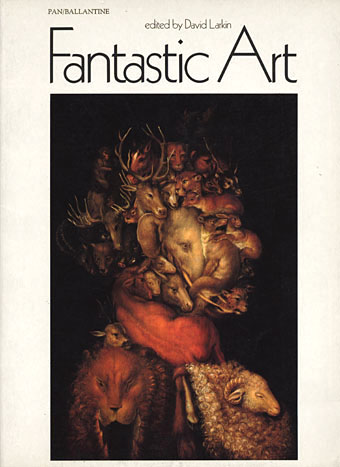
Fantastic Art (1973).
Cover: Earth by Arcimboldo.
I’d thought of writing something about this book series even before I started this weblog since there’s very little information to be found about it online. I can’t compete with the serious Penguin-heads, and I’m not much of a dedicated book collector anyway, but I do have a decent collection of the art books that Pan/Ballantine published in the UK throughout the 1970s. These were published simultaneously by Ballantine/Peacock Press in the US and nearly all were edited by David Larkin, with Betty Ballantine overseeing the American editions. Two of the series, the Dalí and Magritte, were among the first art books I owned. Over the years I’ve gradually accumulated most of the set, and I always look for their distinctive white spines in secondhand shops.
The Pan books were a uniform size, approximately A4 (297 x 210 mm), with a single picture on each recto page and generous margins. The reproductions were excellent, printed on quality paper, and all featured specially-commissioned introductions (Ballard for the Dalí book) with those pages printed on textured sheets. Each book was beautifully designed, with the opening pages and introductions often featuring black-and-white vignettes if the artists in question produced line drawings. David Larkin’s focus was on art that tended to the fantastic, visionary or imaginative, something that was in vogue throughout the Seventies after psychedelic art had ransacked the Victorian and Edwardian eras for inspiration a few years earlier. Aubrey Beardsley had been rediscovered in the mid-Sixties (turning up on the cover of Sgt. Pepper) and underground magazines such as Oz and IT helped create a renewed interest in art that would look good when you were stoned or tripping. The Pan books weren’t “head books” as such but its probably fair to say that the series was supported and made possible by that spirit.
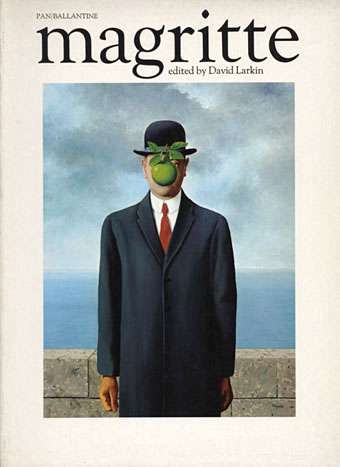
Magritte (1972).
Cover: The Son of Man.
As the series developed, the format evolved away from fine art towards contemporary fantasy art, and as a result became less interesting for me, although the success of the Frank Frazetta books undoubtedly meant that this was the way the sales were going. The demand for the Ernst and Rousseau titles can be gauged by the remainder cut-outs on their covers. The final volumes (which I’ve never bought) featured artists such as Brian Froud (The Dark Crystal), Alan Lee (The Lord of the Rings) and others, with their Faeries, Giants, Castles and Gnomes books. I’m still missing a couple of the earlier numbers which I could now order online but that would spoil the game of letting chance deliver the goods, wouldn’t it?
Fantastic Art is easily my favourite, a great collection of visionary work through the ages beginning with Bosch and proceeding through Goya, John Martin, Richard Dadd, the Symbolists and the Surrealists to what was then contemporary work by artists such as Hundertwasser. This was one of the first of the series and seems to be the key volume in the way it provides an overview of the art that would follow.
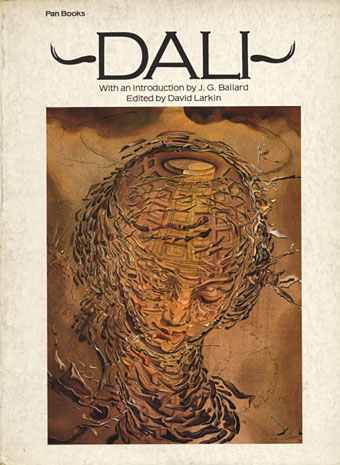
Dali (1974).
Cover: Raphaelesque Head Exploding.
A great introduction by JG Ballard in this one, replete with the usual phrases about “the dark causeways of our spinal columns”.
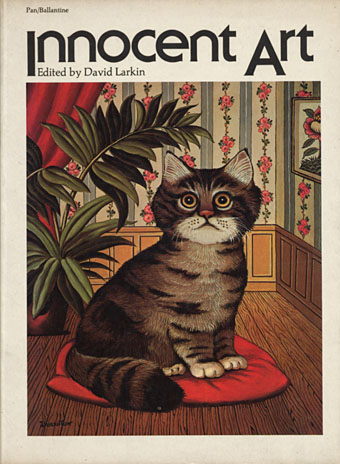
Innocent Art (1974).
Cover: Cat by André Duranton.
A collection of what used to be called naive painting, ie: work by unschooled “Sunday painters” such as Rousseau. Outsider art is the preferred term these days even though the work itself hasn’t always changed.
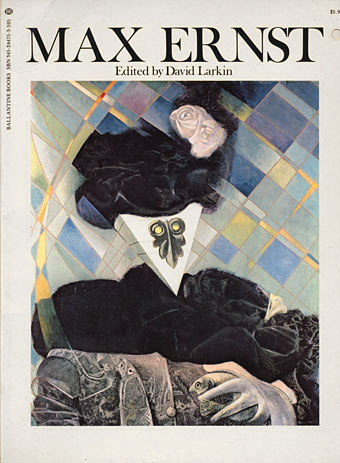
Max Ernst (1975).
Cover: Euclid.
Ernst’s later work in this book was the most abstract and experimental of the series. Europe After the Rain was printed across a fold-out sheet so that its full width could be displayed.
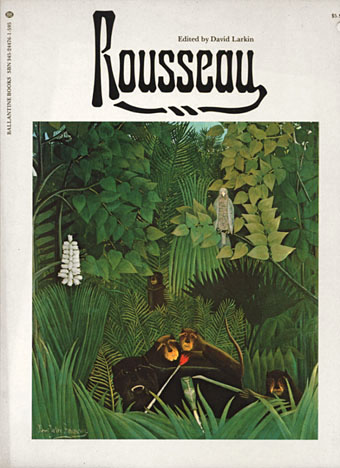
Rousseau (1975).
Cover: The Merry Jesters.
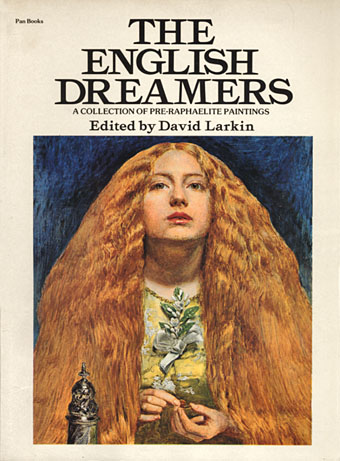
The English Dreamers (1975).
Cover: The Bridesmaid by John Everett Millais.
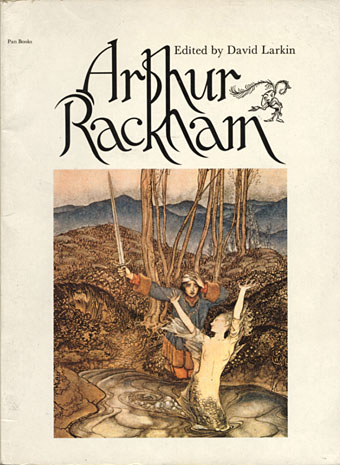
Arthur Rackham (1975).
Cover: Clerk Colville (from Some British Ballads).
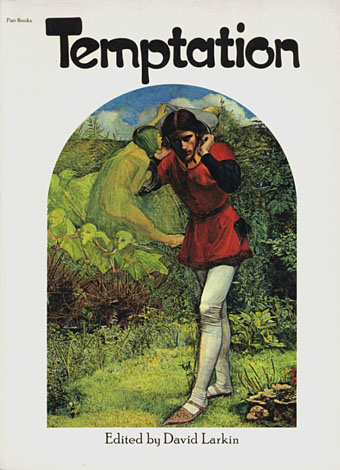
Temptation (1975).
Cover: Ferdinand Lured by Ariel by John Everett Millais.
An unusual collection with a wide range of pictures (Bosch, Alma-Tadema, Balthus). Mainly concerns sexual temptation for female bodies but also includes Biblical and other temptations.
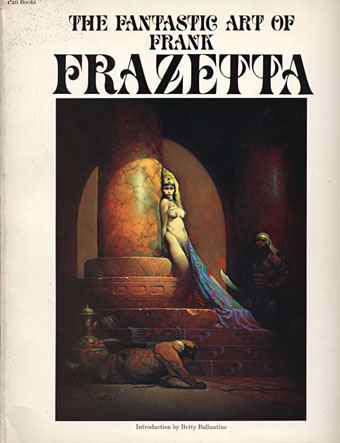
The Fantastic Art of Frank Frazetta (1975).
Cover: Egyptian Queen.
The book that launched a thousand metal albums. Volume One here was the first attempt to collect Frazetta’s work and was easily the most popular title of the series, going through many reprintings and prompting three more volumes to follow. Many of the reproductions are superior to their equivalents in Taschen’s later Icon collection. This was the first one I bought after the Surrealist books and, while I’ve never been a muscle obsessive, I couldn’t help but notice all the male flesh on display.
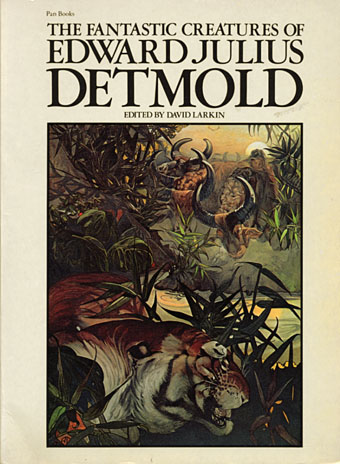
The Fantastic Creatures of Edward Julius Detmold (1976).
Cover: Shere Khan in the jungle (from The Jungle Book).
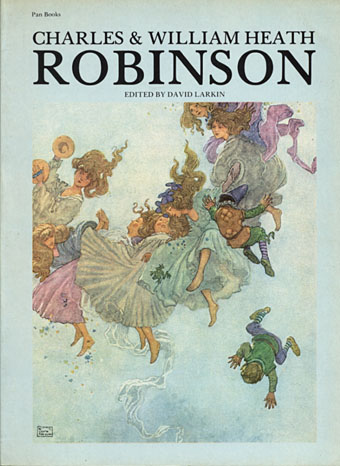
Charles and William Heath Robinson (1976).
Cover: Elfin Mount (from Hans Andersen’s Fairy Tales).
A collection of the Robinsons’ fairy tale paintings. A break from the format with a blue cover.
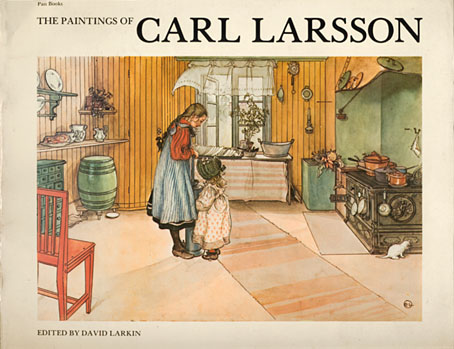
The Paintings of Carl Larsson (1976).
Cover: The Kitchen.
Another break with the format, the book being printed landscape to suit Larsson’s drawings and paintings. As with the Ernst book, a fold-out page was a special feature.
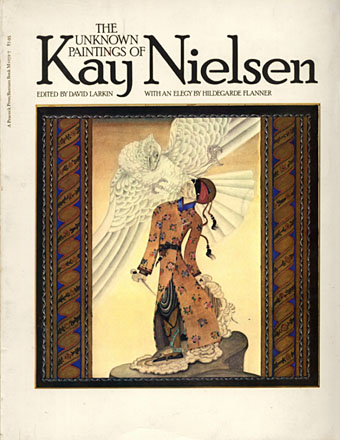
The Unknown Paintings of Kay Nielsen (1977).
Cover: The Tale of the Third Dervish.
A collection of Nielsen’s work derived from Turkish and Persian miniatures.
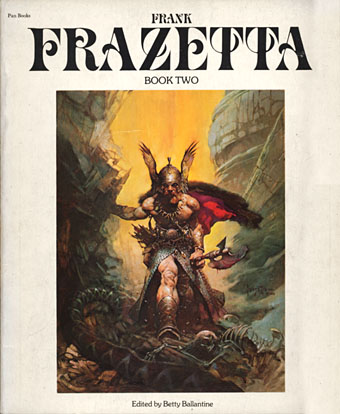
Frank Frazetta, Book Two (1977).
Cover: Dark Kingdom.
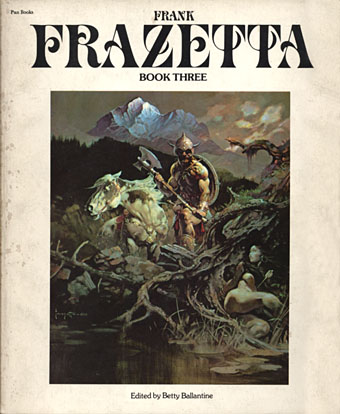
Frank Frazetta, Book Three (1978).
Cover painting: Nightwinds.
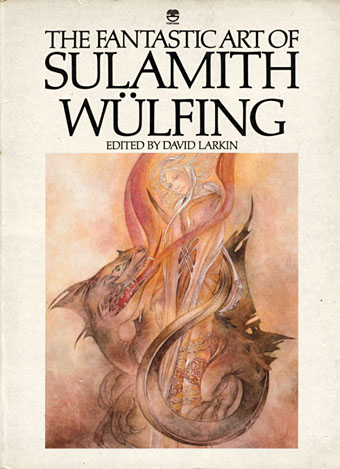
The Fantastic Art of Sulamith Wülfing (1978).
Cover: The Big Dragon.
Part of the series but published by Fontana/Collins, not Pan.
Elsewhere on { feuilleton }
• The fantastic art archive
• The book covers archive
• The illustrators archive

JOHN,
These certainly bring back memories. I have a several of those Pan/Ballantine art books in my collection. I haven’t looked at them in years. I worked in a counter cultural bookshop in those days and remember how popular those particular artists, along with fantastic & decadent art, were at the time.
Anne
I recognize a few items there (two of the Frazetta’s for instance – I never knew they had made a volume three) from my parent’s book shelves. The memories of hours spent with my nose in those books !
John
‘Fantastic Art’ is one of the great art books of all time. Which begs the question, why did I get rid of it? (A situation to be rectified courtesy of Abebooks today.)
My favourite image from the book is the Clovis Trouille painting, where he indulges his nun fantasies to the hilt.
Like yourself, I’m no obsessive book collector, but thanks for this feature, which suggests more than a few titles to add to my modest collection.
That centipede press (I finally got their Lovecraft-Art book preordered) is also doing a comprehensive book on Max Ernst, which will be, from what what I’ve seen, just as expensive if not more. Sometimes its a shame to not be rich. If it was something less artistic or well-crafted, I’d consider just stealing one when they came out – ha. I’ll just have to see if I can track down and buy Pan’s book instead. Do they have a website or are they defunct? Of course, I could just check myself.
Rik: that’s one of the things I like about these books, Larkin chose a lot of works that aren’t at all obvious or well-known, the Trouille being a good example.
Wiley: Pan is still going but is now part of the Pan Macmillan group, as is the once great Picador imprint. You can find these books (or some of them) on abe.com if you have the money. A cheaper solution would probably be to look for the book that Taschen did about Ernst a few years ago. And Dover were still doing his brilliant collage book, Une Semaine de Bonté, last time I looked.
Forgot that was Ernst who did Une Semaine . . . ., there are so many collage artists nowadays its confusing and I’ve never really cared for the medium anyway. It (the book)has so many fans as well as fanatics, many of whom I know, including the person who first introduced me to Huysmans.
If its Ernst then perhaps I should give it a look.
Hi John
I was perusing the covers, that one by Rousseau, “The Merry Jesters”, was used in Brazil, by L&PM Publishers, as cover of the book “The Yage Letters”, by Burroughs/Ginsberg, back in the 80’s (1985, if I´m not mistaken). Just a tip for your feuilleton.
Best regards
Márcio
Thanks Marcio. That’s one that could be added to the Burroughs cover archive linked above.
Hey, John
Unfortunately, I do not have the Burroughs/Ginsberg YAGE LETTERS, in Portuguese anymore, I’ve traded it for a City Lights Books edition of the 60’s, which cover isn’t all that weird (I mean, THE MERRY JESTERS and Burroughs seaching for yage in South America, I see no link, except, perhaps, for the animals in the cover, maybe?). But, that´s just the way things are, right?
That’s it, man, I’m still perusing your feuilleton, watching for old and rare books, and book covers.
All the best
Márcio
I don’t know if anyone is able to assist here…last year when I was travelling in India my house flooded with water….I lost my favourite book Fantastic Art edited by David Larkin, with my very favourite picture painted by Belgian surrealist Paul Delveaux, and I am searching to replace this…the book was a family owned possession passed to me by my uncle when I was nine…I am now forty one and dearly missing this beautiful and mysterious publication…please eamil me if you are able to enlighten further on how to aquire a copy…thankyou so much for the page image and information, even this alone is wonderful.
Hi Genevieve. The place to look for any out of print book is Abe.com. I just used Abe’s detailed search for this title and there are 19 copies for sale from UK booksellers alone, most of them very reasonably-priced.
I had a collection of books including Fantastic Art & rare Giger which I’d collected over time from the age of 9. I unfortunately took them to a ‘friends’ place who’s brother was interested in art in my 20’s and to cut a long story short – I never saw them again. I’ve pined for them ever since. They had a huge impact on me and my interest in art. The full page reproductions & the wide range of artists was a wonderful marriage under the one title. The sketch for Crazy Jane by Richard Dadd still captivates & haunts me, as does one painting of a eerie dark gate in a hazy back lit forest (I can’t recall it’s name/artist). I have been scouring the net, & book stores since then in an effort to replace them without success for over 12 years. Based in Australia we get a trickle of what is available elsewhere in the publishing world. If I may, should someone know of how to get a hold of any, or alternately, if anyone can list the artists & painting within (so I may source them separately) I would be very grateful. If it wasn’t for this post – I would even be able to show people the cover of Fantastic Art.
Thanks John re: abe.com (I’d read all the posts bar the last 2 and missed your comments until after I’d posted mine. On Abe.com now to replace as many of my fav. missing art books as possible :O)
Hi Pamela. That’s good to hear, I was about to suggest Abe as the place to go. The painting you mention may be the one by Caspar David Friedrich, Abbey in the Oakwood.
You’re a gem. Thank you so much John. I was so excited about locating Fantastic Art that I was up all night tracking paintings from it, checking for my other missing publications on abe, & drawing. I look forward to sourcing some of the other books you’ve highlighted also.
I have “The Fantastic Kingdom” (David Larkin, Pan/Ballantyne 1974). Let me know offline if you’d like a scan of the cover (When the Cock Crowed, by Kay Neilsen).
I used to pour over “Innocent Art” as a child, to the point that when I first saw a European winter I felt like I was returning to a known world, going back into that wonderfully flat yet three dimensional painting… which suddenly appeared in Lars von Trier’s latest film, Melancholia, the lead character of which shares my name, Justine. Oh, and it turns out Durer is quite well known after all! It felt uncanny, but of course probably isn’t. I was named for Laurence Durrell, and these troubled heroine names are bound to be used again and again (I’m more of a Melissa, myself, but that’s another story).
I realise now how lucky I was to have a beautiful copy of “East of the sun, west of the moon” illustrated with Kay Neilsen plates… I was so inspired by the clarity and beauty of her long lines and decorativeness… and was later shocked to discover Neilsen was a man, Kay being a male name in some places.
As for Rousseau, all children should have these paintings in their lives. Thank you for your lovely post, which has really taken me back – and refreshes my appreciation for my privileged and wonderfully full childhood.
Hi, Thankyou again, yes I managed to obtain a copy of Fantastic Art, and very much appreciate it too. I meant to thank earlier for the reference – we have moved on since and now have a two year old child who I very much hope one day will enjoy this book too.